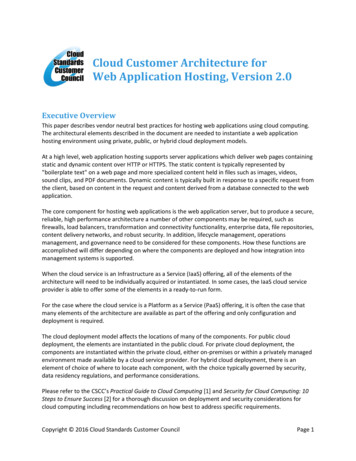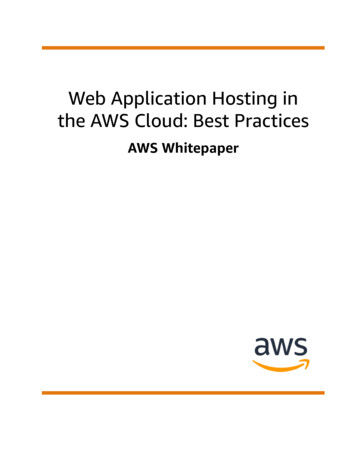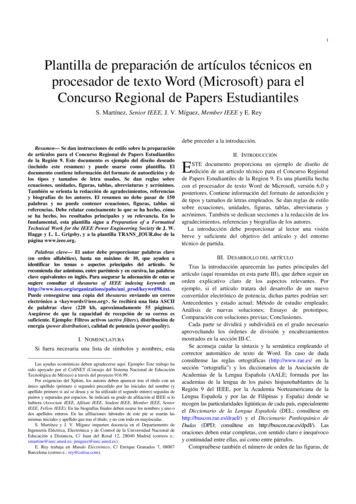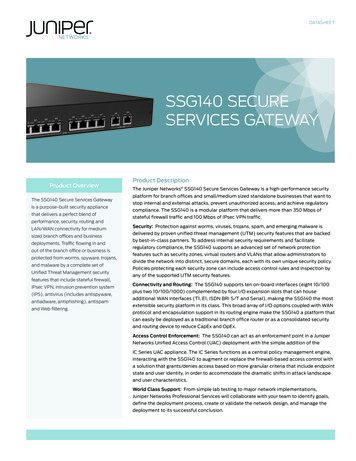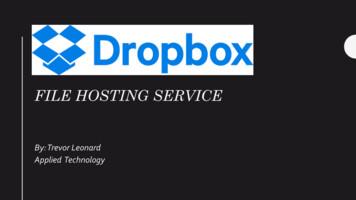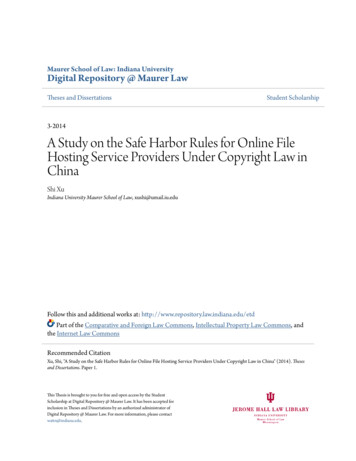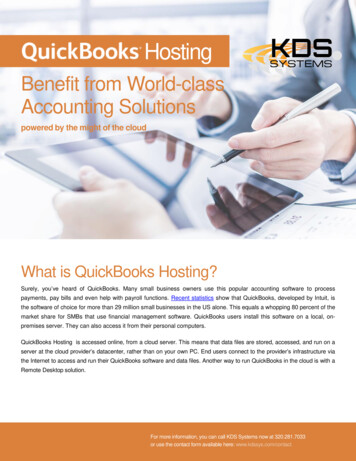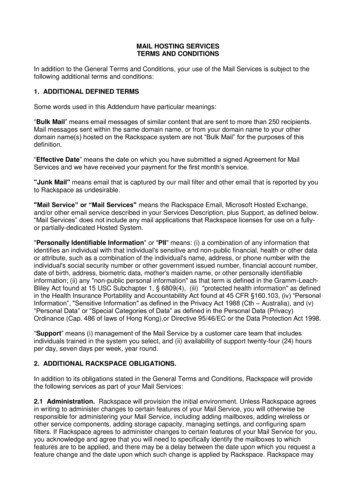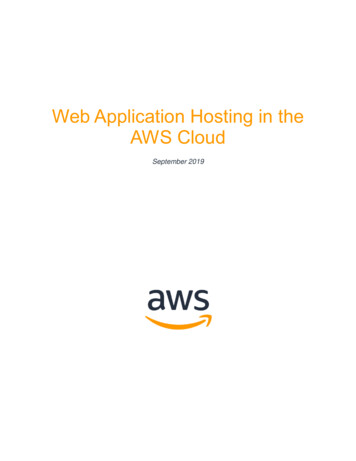
Transcription
Web Application Hosting in theAWS CloudSeptember 2019
NoticesThis document is provided for informational purposes only. It represents AWS’s currentproduct offerings and practices as of the date of issue of this document, which aresubject to change without notice. Customers are responsible for making their ownindependent assessment of the information in this document and any use of AWS’sproducts or services, each of which is provided “as is” without warranty of any kind,whether express or implied. This document does not create any warranties,representations, contractual commitments, conditions or assurances from AWS, itsaffiliates, suppliers or licensors. The responsibilities and liabilities of AWS to itscustomers are controlled by AWS agreements, and this document is not part of, nordoes it modify, any agreement between AWS and its customers. 2019 Amazon Web Services, Inc. or its affiliates. All rights reserved.
ContentsAn Overview of Traditional Web Hosting .1Web Application Hosting in the Cloud Using AWS.2How AWS Can Solve Common Web Application Hosting Issues .2An AWS Cloud Architecture for Web Hosting .4Key Components of an AWS Web Hosting Architecture .5Key Considerations When Using AWS for Web Hosting .14Conclusion .16Contributors .16Further Reading .16Document Revisions.17
AbstractHighly available and scalable web hosting can be a complex and expensive proposition.Traditional scalable web architectures have not only needed to implement complexsolutions to ensure high levels of reliability, but they have also required an accurateforecast of traffic to provide a high level of customer service. Dense peak traffic periodsand wild swings in traffic patterns result in low utilization rates of expensive hardware.This yields high operating costs to maintain idle hardware, and an inefficient use ofcapital for underused hardware.Amazon Web Services (AWS) provides a reliable, scalable, secure, and highlyperforming infrastructure for the most demanding web applications. This infrastructurematches IT costs with customer traffic patterns in real time.This whitepaper is for IT managers and system architects who look to the cloud to helpthem achieve the scalability to meet their on-demand computing needs.
Amazon Web ServicesWeb Application Hosting in the AWS CloudAn Overview of Traditional Web HostingScalable web hosting is a well-known problem space. Figure 1 depicts a traditional webhosting architecture that implements a common three-tier web application model. In thismodel, the architecture is separated into presentation, application, and persistencelayers. Scalability is provided by adding hosts at these layers. The architecture also hasbuilt-in performance, failover, and availability features. The traditional web hostingarchitecture is easily ported to the AWS Cloud with only a few modifications.Figure 1. A traditional web hosting architecturePage 1
Amazon Web ServicesWeb Application Hosting in the AWS CloudIn the following sections, we look at why and how such an architecture should be andcould be deployed in the AWS Cloud.Web Application Hosting in the Cloud UsingAWSThe first question that you should ask concerns the value of moving a classic webapplication hosting solution into the AWS Cloud. If you decide that the cloud is right foryou, you’ll need a suitable architecture. This section helps you evaluate an AWS Cloudsolution. It compares deploying your web application in the cloud to an on-premisesdeployment, presents an AWS Cloud architecture for hosting your application, anddiscusses the key components of this solution.How AWS Can Solve Common Web ApplicationHosting IssuesIf you’re responsible for running a web application, you face a variety of infrastructureand architectural issues for which AWS can provide seamless and cost-effectivesolutions. The following are just some of the benefits of using AWS over a traditionalhosting model.A Cost-Effective Alternative to Oversized Fleets Needed to HandlePeaksIn the traditional hosting model, you have to provision servers to handle peak capacity.Unused cycles are wasted outside of peak periods. Web applications hosted by AWScan leverage on-demand provisioning of additional servers, so you can constantlyadjust capacity and costs to actual traffic patterns.For example, the following graph shows a web application with a usage peak from 9AMto 3PM and less usage for the remainder of the day. An automatic scaling approachbased on actual traffic trends, which provisions resources only when needed, wouldresult in less wasted capacity and a greater than 50 percent reduction in cost.Page 2
Amazon Web ServicesWeb Application Hosting in the AWS CloudFigure 2. An example of wasted capacity in a classic hosting modelA Scalable Solution to Handling Unexpected Traffic PeaksAn even more dire consequence of the slow provisioning associated with a traditionalhosting model is the inability to respond in time to unexpected traffic spikes. There aremany stories about web applications going down because of an unexpected spike intraffic after the site is mentioned in the popular media. The same on-demand capabilitythat helps web applications scale to match regular traffic spikes can also handle anunexpected load. New hosts can be launched and ready in a matter of minutes, andthey can be taken offline just as quickly when traffic returns to normal.An On-Demand Solution for Test, Load, Beta, and PreproductionEnvironmentsThe hardware costs of building out a traditional hosting environment for a productionweb application don’t stop with the production fleet. Quite often, you need to createpreproduction, beta, and testing fleets to ensure the quality of the web application ateach stage of the development lifecycle. While you can make various optimizations toensure the highest possible use of this testing hardware, these parallel fleets are notalways used optimally: a lot of expensive hardware sits unused for long periods of time.In the AWS Cloud, you can provision testing fleets as you need them. Additionally, youcan simulate user traffic on the AWS Cloud during load testing. You can also use thesePage 3
Amazon Web ServicesWeb Application Hosting in the AWS Cloudparallel fleets as a staging environment for a new production release. This enablesquick switchover from current production to a new application version with little or noservice outages.An AWS Cloud Architecture for Web HostingThe following figure provides another look at that classic web application architectureand how it can leverage the AWS Cloud computing infrastructure.Figure 3. An example of a web hosting architecture on AWS1. Load Balancing with Elastic Load Balancing (ELB)/Application LoadBalancer (ALB) – Allows you to spread load across multiple Availability ZonesPage 4
Amazon Web ServicesWeb Application Hosting in the AWS Cloudand Amazon EC2 Auto Scaling groups for redundancy and decoupling ofservices.2. Firewalls with Security Groups –Moves security to the instance to provide astateful, host-level firewall for both web and application servers.3. Caching with Amazon ElastiCache – Provides caching services with Redis orMemcached to remove load from the app and database, and lower latency forfrequent requests.4. Managed Database with Amazon RDS – Creates a highly available, Multi-AZdatabase architecture with six possible DB engines.5. DNS Services with Amazon Route 53 – Provides DNS services to simplifydomain management.6. Edge Caching with Amazon CloudFront – Edge caches high-volume contentto decrease the latency to customers.7. Edge Security for Amazon CloudFront with AWS WAF – Filters malicioustraffic, including XSS and SQL injection via customer-defined rules.8. DDoS Protection with AWS Shield – Safeguards your infrastructure against themost common network and transport layer DDoS attacks automatically.9. Static Storage and Backups with Amazon S3 – Enables simple HTTP-basedobject storage for backups and static assets like images and video.Key Components of an AWS Web HostingArchitectureThe following sections outline some of the key components of a web hostingarchitecture deployed in the AWS Cloud, and explain how they differ from a traditionalweb hosting architecture.Network ManagementIn a cloud environment such as AWS, the ability to segment your network from that ofother customers enables a more secure and scalable architecture. While securitygroups provide host-level security (see the Host Security section), Amazon VirtualPage 5
Amazon Web ServicesWeb Application Hosting in the AWS CloudPrivate Cloud (Amazon VPC) allows you to launch resources in a logically isolated andvirtual network that you define.1Amazon VPC is a free service that gives you full control over the details of yournetworking setup in AWS. Examples of this control include creating public-facingsubnets for web servers, and private subnets with no internet access for yourdatabases. Additionally, Amazon VPC enables you to create hybrid architectures byusing hardware virtual private networks (VPNs), and use the AWS Cloud as anextension of your own data center.Amazon VPC also includes IPv6 support in addition to traditional IPv4 support for yournetwork.Content DeliveryEdge caching is still relevant in the AWS Cloud computing infrastructure. Any existingsolutions in your web application infrastructure should work just fine in the AWS Cloud.One additional option, however, is to use Amazon CloudFront for edge caching yourwebsite.2You can use CloudFront to deliver your website, including dynamic, static, andstreaming content using a global network of edge locations. CloudFront automaticallyroutes requests for your content to the nearest edge location, so content is deliveredwith the best possible performance. CloudFront is optimized to work with other AWSservices, like Amazon Simple Storage Service3 (Amazon S3) and Amazon ElasticCompute Cloud4 (Amazon EC2). CloudFront also works seamlessly with any originserver that is not an AWS origin server, which stores the original, definitive versions ofyour files.Like other AWS services, there are no contracts or monthly commitments for usingCloudFront – you pay only for as much or as little content as you actually deliverthrough the service.Managing Public DNSMoving a web application to the AWS Cloud requires some DNS changes to takeadvantage of the multiple Availability Zones that AWS provides. To help you manageDNS routing, AWS provides Amazon Route 53,5 a highly available and scalable DNSweb service. Amazon Route 53 automatically routes queries for your domain to thePage 6
Amazon Web ServicesWeb Application Hosting in the AWS Cloudnearest DNS server. As a result, queries are answered with the best possibleperformance. Amazon Route 53 resolves requests for your domain name (for example,www.example.com) to your Classic Load Balancer, as well as your zone apex record(example.com).Host SecurityUnlike a traditional web hosting model, inbound network traffic filtering should not beconfined to the edge; it should also be applied at the host level. Amazon EC2 provides afeature named security groups. A security group is analogous to an inbound networkfirewall, for which you can specify the protocols, ports, and source IP ranges that areallowed to reach your EC2 instances. You can assign one or more security groups toeach EC2 instance. Each security group routes the appropriate traffic to each instance.Security groups can be configured so that only specific subnets or IP addresses haveaccess to an EC2 instance. Or they can reference other security groups to limit accessto EC2 instances that are in specific groups.Figure 4. Security groups in a web applicationPage 7
Amazon Web ServicesWeb Application Hosting in the AWS CloudIn the example AWS web hosting architecture in Figure 4, the security group for the webserver cluster might allow access for any host only over TCP on ports 80 and 443(HTTP and HTTPS), and from instances in the application server security group on port22 (SSH) for direct host management. The application server security group, on theother hand, might allow access from the web server security group for handling webrequests and from your organization’s subnet over TCP on port 22 (SSH) for direct hostmanagement. In this model, your support engineers could log in directly to theapplication servers from the corporate network and then access the other clusters fromthe application server boxes. For a deeper discussion on security, see the AWSSecurity Center.6 The center contains security bulletins, certification information, andsecurity whitepapers that explain the security capabilities of AWS.Load Balancing Across ClustersHardware load balancers are a common network appliance used in traditional webapplication architectures. AWS provides this capability through the Elastic LoadBalancing7 (ELB) service. ELB is a configurable load-balancing solution that supportshealth checks on hosts, distribution of traffic to EC2 instances across multipleAvailability Zones, and dynamic addition and removal of Amazon EC2 hosts from theload-balancing rotation. ELB can also dynamically grow and shrink the load-balancingcapacity to adjust to traffic demands, while providing a predictable entry point by using apersistent CNAME. ELB also supports sticky sessions to address more advancedrouting needs. If your application requires more advanced load-balancing capabilitiesyou can run a software load-balancing package (e.g., Zeus, HAProxy, or NGINX Plus)on EC2 instances. You can then assign Elastic IP addresses to those load-balancingEC2 instances to minimize DNS changes.8Finding Other Hosts and ServicesIn the traditional web hosting architecture, most of your hosts have static IP addresses.In the cloud, most of your hosts will have dynamic IP addresses. Although every EC2instance can have both public and private DNS entries and will be addressable over theinternet, the DNS entries and the IP addresses are assigned dynamically when youlaunch the instance. They cannot be manually assigned. Static IP addresses (Elastic IPaddresses in AWS terminology) can be assigned to running instances after they arelaunched. You should use Elastic IP addresses for instances and services that requirePage 8
Amazon Web ServicesWeb Application Hosting in the AWS Cloudconsistent endpoints, such as master databases, central file servers, and EC2-hostedload balancers.Server roles that can easily scale out and in, such as web servers, should be madediscoverable at their dynamic endpoints by registering their IP address with a centralrepository. Because most web application architectures have a database server that isalways on, the database server is a common repository for discovery information. Forsituations where consistent addressing is needed, instances can be allocated Elastic IPaddresses from a pool of addresses by a bootstrapping script when the instance islaunched.Using this model, newly added hosts can request the list of necessary endpoints forcommunications from the database as part of a bootstrapping phase. The location of thedatabase can be provided as user data9 that is passed into each instance as it islaunched. Alternatively, you can use Amazon SimpleDB to store and maintainconfiguration information.10 SimpleDB is a highly available service that is available at awell-known endpoint.Caching within the Web ApplicationIn-memory application caches can reduce load on services and improve performanceand scalability on the database tier by caching frequently used information. AmazonElastiCache11 is a web service that makes it easy to deploy, operate, and scale an inmemory cache in the cloud. You can configure the in-memory cache you create toautomatically scale with load and to automatically replace failed nodes. ElastiCache isprotocol-compliant with Memcached and Redis, which simplifies migration from yourcurrent on-premises solution.Database Configuration, Backup, and FailoverMany web applications contain some form of persistence, usually in the form of arelational or NoSQL database. AWS offers both relational and NoSQL databaseinfrastructure. Alternatively, you can deploy your own database software on an EC2instance. The following table summarizes these options, and we discuss them in greaterdetail in this section.Page 9
Amazon Web ServicesWeb Application Hosting in the AWS CloudRelational Database SolutionsNoSQL SolutionsManaged DatabaseServiceAmazon RDS – MySQL, Oracle,SQL Server, MariaDB,PostgreSQL, Amazon AuroraAmazon DynamoDBSelf-ManagedHosting a relational DBMS on anEC2 instanceHosting a NoSQL solution onan EC2 instanceAmazon RDSAmazon Relational Database Service (Amazon RDS) gives you access to thecapabilities of a familiar MySQL, PostgreSQL, Oracle, and Microsoft SQL Serverdatabase engine.12 The code, applications, and tools that you already use can be usedwith Amazon RDS. Amazon RDS automatically patches the database software andbacks up your database, and it stores backups for a user-defined retention period. Italso supports point-in-time recovery. You benefit from the flexibility of being able toscale the compute resources or storage capacity associated with your relationaldatabase instance by making a single API call.In addition, Amazon RDS Multi-AZ deployments increase your database availability andprotect your database against unplanned outages. Amazon RDS Read Replicas provideread-only replicas of your database, so you can scale out beyond the capacity of asingle database deployment for read-heavy database workloads. As with all AWSservices, no upfront investments are required, and you pay only for the resources youuse.Hosting a Relational Database Management System (RDBMS) on an Amazon EC2InstanceIn addition to the managed Amazon RDS offering, you can install your choice ofRDBMS (such as MySQL, Oracle, SQL Server, or DB2) on an EC2 instance andmanage it yourself. AWS customers hosting a database on Amazon EC2 successfullyuse a variety of master/slave and replication models, including mirroring for read-onlycopies and log shipping for always-ready passive slaves.When managing your own database software directly on Amazon EC2, you should alsoconsider the availability of fault-tolerant and persistent storage. For this purpose, wePage 10
Amazon Web ServicesWeb Application Hosting in the AWS Cloudrecommend that databases running on Amazon EC2 use Amazon Elastic Block Store(Amazon EBS) volumes,13 which are similar to network-attached storage. For EC2instances running a database, you should place all database data and logs on EBSvolumes. These will remain available even if the database host fails. This configurationallows for a simple failover scenario, in which a new EC2 instance can be launched if ahost fails, and the existing EBS volumes can be attached to the new instance. Thedatabase can then pick up where it left off.EBS volumes automatically provide redundancy within the Availability Zone, whichincreases their availability over simple disks. If the performance of a single EBS volumeis not sufficient for your databases needs, volumes can be striped to increase IOPSperformance for your database. For demandin
application hosting solution into the AWS Cloud. If you decide that the cloud is right for you, you’ll need a suitable architecture. This section helps you evaluate an AWS Cloud solution. It compares deploying your web application in the cloud to an on-premises deployment, presents an AWS Cloud architecture for hosting your application, and
